
India's vision of Indo - Pacific: Concept and Structure
Latest
| TIN LIÊN QUAN | |
| Shangri-La 2018 in Singapore wraps up | |
| Ambassador: Vietnam-India ties increasingly important to Indo-Pacific | |
Traditionally, the Indo-Pacific, sometimes known as the Indo-West Pacific, is a biogeographic region of the Earth's seas, comprising the tropical waters of the Indian Ocean, the western and central Pacific Ocean, and the seas connecting the two in the general area of Indonesia. It does not include the temperate and polar regions of the Indian and Pacific oceans, and the Tropical Eastern Pacific, along the Pacific coast of the Americas, is also a distinct marine realm.
However, from an Indian perspective, the region Indo-Pacific’ refers to the maritime space stretching from the littorals of East Africa and West Asia, across the Indian Ocean and western Pacific Ocean, to the littorals of East Asia. Apart from Australian and Indian scholars, the term was picked up by Japan’s Prime Minister Shinzo Abe, as reflected in his speech to the Indian Parliament in August 2007 that talked about the "Confluence of the Indian and Pacific Oceans" as "the dynamic coupling as seas of freedom and of prosperity" in the "broader Asia".
From 2010 onwards, the term Indo-Pacific began to be used by the Indian government and scholars to indicate New Delhi’s broad strategic and economic interests in a region of its extended neighbourhood and what can possibly constitute a ‘security complex’ in the words of Barry Buzan, the British strategic thinker.
Whereas in the in the past and particularly during the period of Cold War period, each regions in Asia had its own security complexes and they did not intersect with each other, but the rise of China as an economic giant and a rising military power and the consequent shift of international politics and relations to Asia as the fulcrum changed all the old ideas of security complexes and turned the whole region of Indo-Pacific as one security complex in which not only countries that are part of the region that has stakes in peace and stability of the region but also countries that are adjacent or outside the region.
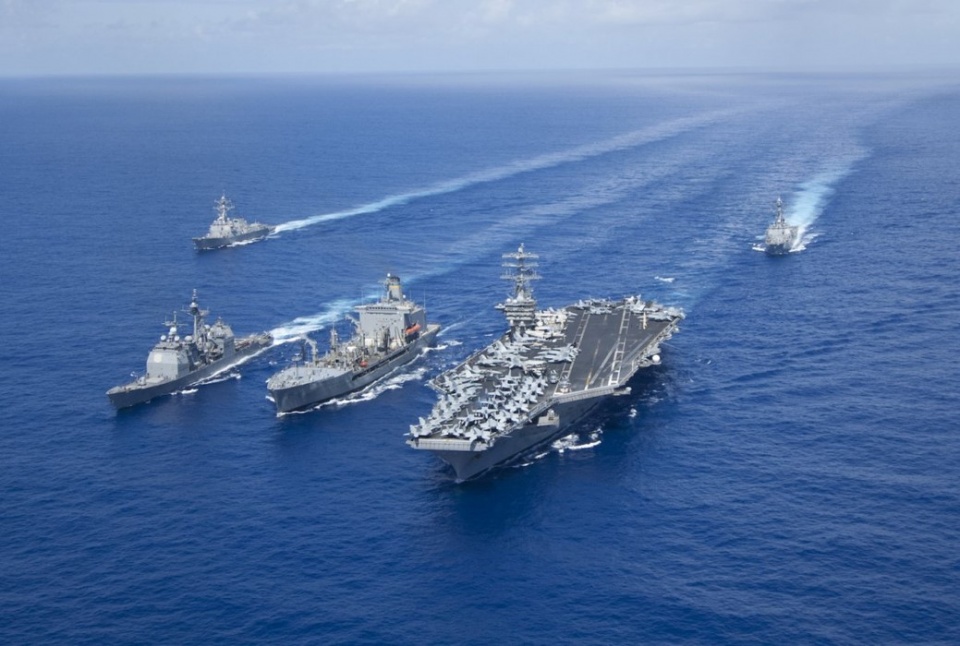 |
| USS Nimitz and a number of US warships operating in the Asia - Pacific Ocean. (Photo: US Navy) |
Therefore, we find that from about 2011 onwards, the term has been used frequently by strategic analysts and high-level government/ military leadership in Australia, Japan and the US to denote the said region. However, a formal/ official documented articulation of the term first appeared in Australia’s Defence White Paper, 2013. The concept of the Indo-Pacific, therefore, have brought about a change in popular "mental maps" of how the world is understood in strategic terms. The United States first began using the term "Indo-Asia Pacific," as an attempt to maintain its geographic inclusiveness in the new coinage of 'Indo-Pacific', but have now reconciled and started using the term as a compact region as a move to recognize India’s emergence as an important player in the evolving geo-politics of the region.
Globalization and regional trade
Furthermore, the onset of globalization which has increased manifold the volume of trade and other transactions between nations together with rival claims for exploitation of offshore resources has highlighted the importance of freedom of navigation and securing global commons, and thus importance of linkage between foreign policy and oceans. India together with Japan, Indonesia, Vietnam, Philippines are island nations and carry bulk of their trade through the oceans and, therefore, have a strong stake in freedom of navigation in the Sea Lanes of Communication both in the Indian and the Pacific Oceans.
Because of this stake it is imperative for these nations to promote a structure and a code which can ensure freedom of navigation dictated by international laws and norms. The recent assertive notion of China’s claim over almost the entire South China Seas and its declaration of laws that requires its permission for other nations for fishing in the claimed territorial waters of China as well as Air Defence Identification Zone (ADIZ) make it even more important for the countries adjoining the oceans to look for a mechanism in accordance with the international law that would protect the rights of the nations to pursue global commons.
The Indo-Pacific Construct?
Notwithstanding the desire of each and every country to look for a mechanism that can guarantee peace, prosperity and the rights of nations in the region to pursue and secure global commons, there is no consensus as how these would be achieved and what kind of institutional structure or grouping that would be suitable or acceptable to all.
As Allan Gyngell, an Australian scholar has aptly put: “There is, of course, no such thing as the Indo-Pacific. Like the Asia Pacific, or Asia itself, the Indo-Pacific is simply a way for governments to frame the international environment to suit their policy objectives in particular circumstances.’ In other words, each country is trying to define the Indo-Pacific construct in their own way that can serve their own political, economic and security interests within a broader region.
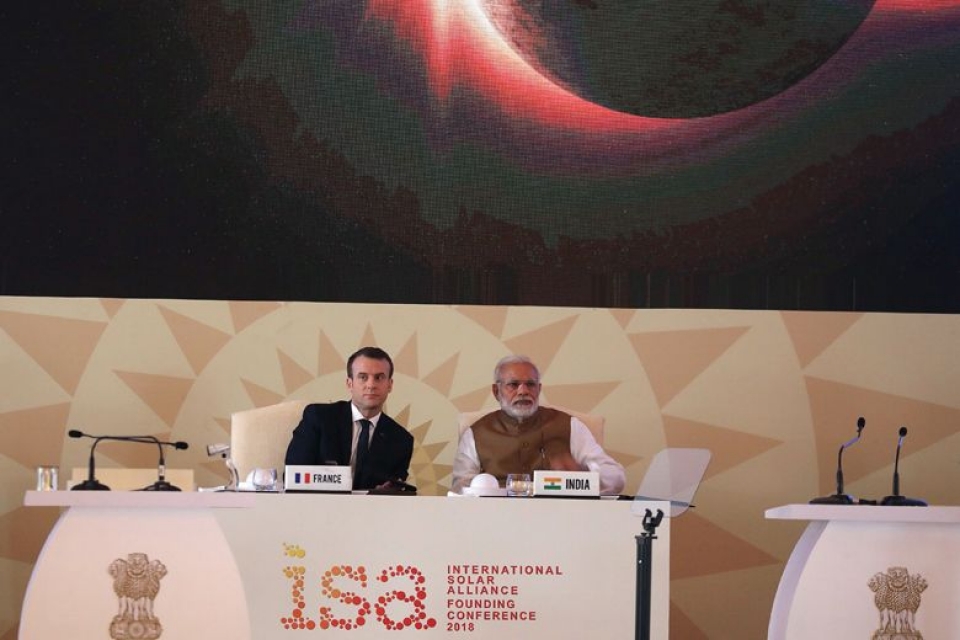 |
| French President Emmanuel Macron and Indian Prime Minister Narendra Modi at the International Solar Alliance Summit 2018. (Photo: AFP) |
And the number of countries who are subscribing to this construct of Indo-Pacific are gradually increasing, latest convert being France, whose President Macron, while in India in March this year, agreed to broaden Paris’ ties with New Delhi through a joint strategic vision for cooperation hat emphasized on the need to establish an open, inclusive and transparent cooperation architecture for peace, security and prosperity in the Indo-Pacific region.
He used the term again in Sydney in May when he talked about France’s objective “to preserve a rule-based development in the region and especially in the Indo-Pacific region. It's to preserve the necessary balances in the region. . . . not to have any hegemony In the region. That's why for me, this partnership . . . India and all the partners, this is not an initiative against or in reaction to. That's a positive initiative, to say: We have something in common . . . we do want to favour free movement in the region, free movement in Indo-Pacific region. ’Though France is not against the quad of India, the US, Japan and Australia, Paris would rather like to work with New Delhi bilaterally in the Indian Ocean Region given that there are around two million French citizens in its territories in the region.
US vision of Indo-Pacific and the role of India
The driving force behind the growing use of the Indo-Pacific construct, however, is China’s rise and the consequent fall out of that development on the Asian geo-politics and the “more general westwards reweighting of power within Asia — from Japan to China, from the Chinese coast to the hinterland and outwards to India. It is best understood as a maritime counterpart (and in some eyes a counterweight) to the shifting forces across continental Eurasia. It encompasses the energy supplies, production chains, infrastructure and security connections — both state and non-state — that link the Middle East, West Asia and East Asia. It also incorporates US security and economic connections across the Pacific,” to quote Allan Gyngell again.
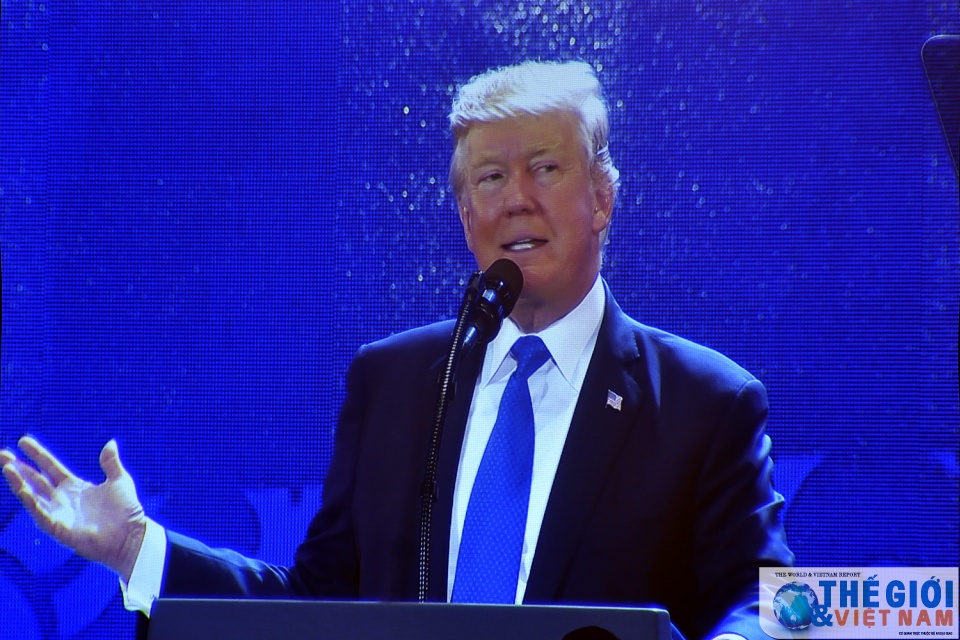 |
| US President Donald Trump spoke at the APEC CEO Summit 2017 in Da Nang, Vietnam. (Photo: Tuấn Anh) |
And it is here that US’ use of the term ‘Indo-Pacific gains salience. President Trump, during his12-day tour through Asia in late 2017, had used “Indo-Pacific’ quite extensively in lieu of the long established “Asia-Pacific,” prompting the US administration to use the term throughout the U.S. National Security Strategy published soon after Trump’s Asia trip -- a document that alleged China aims to “challenge American power” and “is using economic inducements and penalties, influence operations, and implied military threats to persuade other states to heed its political and security agenda.” To keep in line with the US agenda to counter China’s hegemony in the region and to bring in as many friends as possible to achieve that objective, US Defence Secretary Mattis announced in Hawaii at the end of May this year that the U.S. Pacific Command would be renamed the Indo-Pacific Command, describing the expanded theatre as stretching “from Bollywood to Hollywood," adding three days later in Singapore at the Shangri-La Dialogue that “standing shoulder to shoulder with India, ASEAN and our treaty allies and other partners, America seeks to build an Indo-Pacific where sovereignty and territorial integrity are safeguarded -- the promise of freedom fulfilled and prosperity prevails for all.”
Prime Minister Modi’s vision of Indo-Pacific
Behind Trump administration’s use of term lies clearly hope for greater Indian involvement in its efforts to counter China's growing influence. And this is reflected in the statement of Kori Schake, deputy director-general of the International Institute for Strategic Studies, when he said that while “Indo-Pacific isn't yet an established part of the lexicon,” the implications of the term are clear. To Schake, “India is an Asian power. The countries adopting the term are encouraging India into greater cooperation in maintaining the maritime commons in the Indian and Pacific oceans.” That brings us to India’s vision of the Indo-Pacific region. While Indian leaders and officials have been using the term Indo-Pacific for some time now, it was left to Prime Minister Narendra Modi to articulate the vision more precisely. Delivering the keynote address at the Shangri-La Dialogue in Singapore, Modi placed this region at the heart of India’s engagement with the world. India’s engagement with the region, which encompasses many of the world’s most dynamic economies, will be undergirded by a positive impulse which seeks to enhance trade and cooperation.
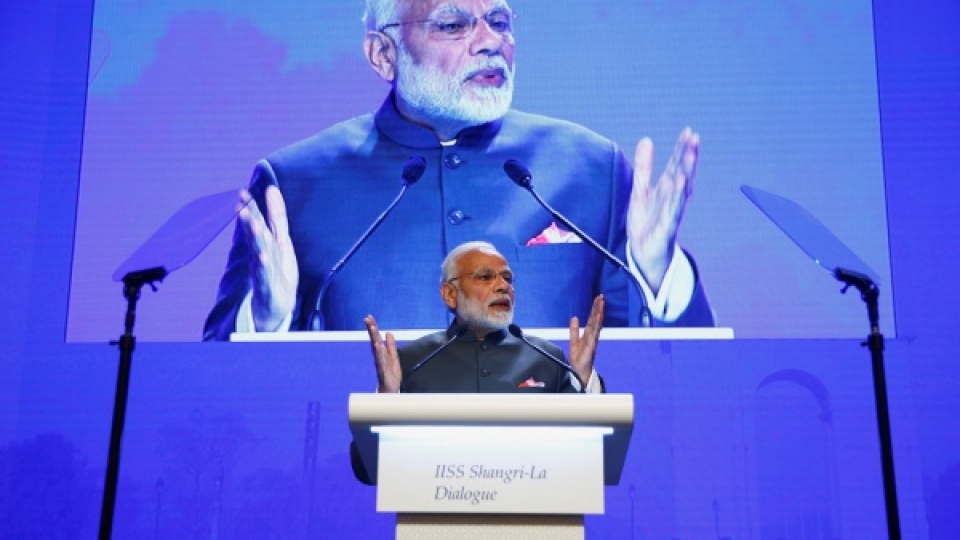 |
| Indian Modi addressed the Shangri-La Dialogue 2018 in Singapore. (Photo: CFR.org) |
He defined this region as stretching from the shores of Africa to that of the Americas, thereby incorporating the Gulf region and Indian Ocean island states left out of popular definitions. This is to be a ‘free, open, inclusive region’ in pursuit of progress and prosperity, the use of the term is not ‘directed against any country’, nor is it to be seen as a ‘grouping that seeks to dominate’. At the same he called for a common rules-based order for the region. Such an order must believe in sovereignty and territorial integrity, as well as equality of all nations, irrespective of size and strength. These rules and norms should be based on the consent of all, not on the power of the few. Another element of the concept of Indo-Pacific is the freedom of navigation, unimpeded commerce and peaceful settlement of disputes in accordance with international law. “When we all agree to live by that code, our sea lanes will be pathways to prosperity and corridors of peace. We will also be able to come together to prevent maritime crimes, preserve marine ecology, protect against disasters and prosper from blue economy,” said Modi.
Unsurprisingly, Modi deliberately did not use the word ‘quad’, the grouping of the US, India, Japan and Australia. For India, the core of the Indo-Pacific region will be ASEAN and India’s ‘Act East’ policy, even as the Indian Ocean holds the ‘key to India’s future’. For India, ASEAN unity is essential for a stable future for this region. Modi declared: “I am convinced that ASEAN can integrate the broader region. In many ways, ASEAN is already leading the process. In doing so, it has laid the foundation of the Indo-Pacific Region. The East Asia Summit and the Regional Comprehensive Economic Partnership – two important initiatives of ASEAN – embrace this geography.” For the first time, Modi stated that his Indian Ocean vision of SAGAR (Security and Growth for All in the Region) unveiled in 2015 will also be applicable to the ‘east’. And in this respect, the relationship with the US is critical. Modi stressed that India and the US shared a vision of an ‘open, stable, secure and prosperous Indo-Pacific Region’ which he described as “a natural region”.
But Modi also heaped praise on China, despite its border dispute with India and increasingly close economic ties with Pakistan, India's neighbour and nuclear rival. “Our cooperation is expanding. Trade is growing. And, we have displayed maturity and wisdom in managing issues and ensuring a peaceful border,” Modi said. The relationship between India and China is key to a positive future, he said. "I firmly believe that Asia and the world will have a better future when India and China work together in trust and confidence, sensitive to each other's interests." The Indo-Pacific region’s potential as the fulcrum of global economic growth has in the recent past been undermined by some of China’s actions. Modi described India’s relationship with China as one with many layers. China remains one of India’s most important trading partners.
At the same time, some of China’s measures to expand its market and build infrastructure are likely to lead to conflict. China’s engagement with India needs to be an equal partnership between two sovereign nations as against an opportunity to engage in mercantilism. India has had both its merchandise and service exports to China hampered by non-tariff barriers. Separately, China’s infrastructure building in south Asia as a part of its larger Belt Road Initiative is already leading to an accumulation of unsustainable debt which will impinge on sovereignty of its partners. The alternative approach is to use infrastructure development as a platform to build “bridges of trust”.
Finally, Modi focused on the importance of naval diplomacy, praising the Indian navy for building partnerships in the region through training, exercises and the conduct of goodwill missions, along with humanitarian assistance and disaster relief. He singled out Singapore for hosting the longest un-interrupted joint naval exercise with his country, now in its 25th year, and mentioned the extension of this to a trilateral exercise. In a little noticed development, and unusually for Indian prime ministerial visits, Modi visited Changi naval port in Singapore. There he went aboard a Singaporean frigate and a visiting Indian naval frigate; emphasising India’s defence ties in the Indo-Pacific.
 |
| Indian Prime Minister Modi and Indonesian President Widodo, May 2018. (Photo: Financial Express) |
During Modi’s visit to Indonesia recently, India signed a Comprehensive Strategic Partnership, and arrived at a common vision for maritime cooperation in the Indo-Pacific. New Delhi will start a new tri-lateral exercise with Singapore soon and wants to extend it to other ASEAN countries.
India has also strategic partnership with Vietnam to build mutual capabilities and has upgraded its defence cooperation, training and military exercises. India conducts Malabar Exercise with the United States and Japan. A number of regional partners join in India’s Exercise Milan in the Indian Ocean, and participate in RIMPAC in the Pacific. Modi’s articulation of India’s vision provides a concrete template for the rules of engagement. If this region is to fulfil its potential, it needs to move towards terms based on transparency and willingness of major players to build relationships based on equality. In its absence, alliances will be based on strategies of containment. This will kill the aspirations of people in the Indo-Pacific region.
Indo-Pacific concept of other middle powers
While the US and India’s vision of the Indo-Pacific construct get primary importance in the discourse on the region, other countries’ views on Indo-Pacific are equally important to get a clear picture of the emerging geo-politics of the Indo-Pacific region. Australia is one of the early proponents of the idea of the Indo-Pacific.
For Australia, it includes both the oceans surrounding the continent, with Southeast Asia acting as the linchpin between them. The words appeared in official Australian statements well before other leaders started using them. The idea has now been formally endorsed in documents from the Gillard, Rudd, Abbott and Turnbull governments.
For Japanese Prime Minister Shinzo Abe, it is more about China. Abe wants to ensure that the infrastructure networks across Asia to Africa are not dominated by China and Chinese standards. Apart from larger states like the United States and India, the smaller countries of Southeast Asia in general as well as the Association of Southeast Asian Nations (ASEAN) play an important role in the context of Japan’s vision of a Free and Open Indo-Pacific Strategy. It is still early days in terms of Japan’s rolling out of its Indo-Pacific Strategy, particularly in Southeast Asia, where there are mixed feelings in different countries about what the strategy is and how it will play out in terms of broader trends, be it links with ideas like the so-called Quad – grouping Japan, Australia, India, and the United States – as well as China’s own growing role in the region.
Indonesia’s Indo-Pacific is tentative. It notes its own centrality to the concept but worries about the potential effect on existing ASEAN institutions and fears hardening divisions with China. Indonesia will also seek a stronger ASEAN presence in the Indo-Pacific region. France’s version is a re-assertion, through its island territories in the Indian and Pacific oceans, of its claims to global power status. China has its own Indo-Pacific in the Maritime Silk Road, part of the Belt and Road Initiative. In the midst of the contrasting perspectives, With ASEAN and India as ‘the backbone’ of maritime cooperation, ASEAN-led mechanisms such as the East Asia Summit (EAS) and the Treaty of Amity and Cooperation (TAC) could be coupled with the Indian Ocean Rim Association (IORA) to ‘bridge and integrate’ the Indian and Pacific oceans.
In the meantime, the concept of sentinels of sea-lanes of communication has already been implemented by India in the western Indo-Pacific, where about 2 dozen Indian Navy ships escort international shipping from the Red Sea to the Indian coast. The bulk of India's maritime trade flows through this sea lane of communication, as does its energy imports, not to mention the undersea fibre optic cables that link India to the internet. These core quantifiable concerns provide the drivers for India to demonstrate its capability in this area. The capability is built on India's experience in deploying naval assets as part of the multi-national task force to combat piracy off the coast of Somalia.
(*) Prof. Baladas Ghoshal is Secretary General, Society for Indian Ocean Studies; Former Professor and Chair in Southeast Asian Studies.
 | Vietnam steps up ties with Singapore, India Standing Deputy Minister of Foreign Affairs Bui Thanh Son paid working visits to Singapore and India from June 21-22 to step up cooperative ties with ... |
 | President voices support for stronger Vietnam-India defence ties The Party and State of Vietnam will create optimal conditions for the Vietnamese and Indian Defence Ministries to cooperate closely and effectively, thus deepening the ... |
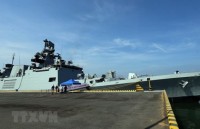 | Indian naval ships visit central Da Nang city Three naval ships of India anchored at Tien Sa Port in Da Nang on May 21, beginning a five-day courtesy visit to the central city. |

















